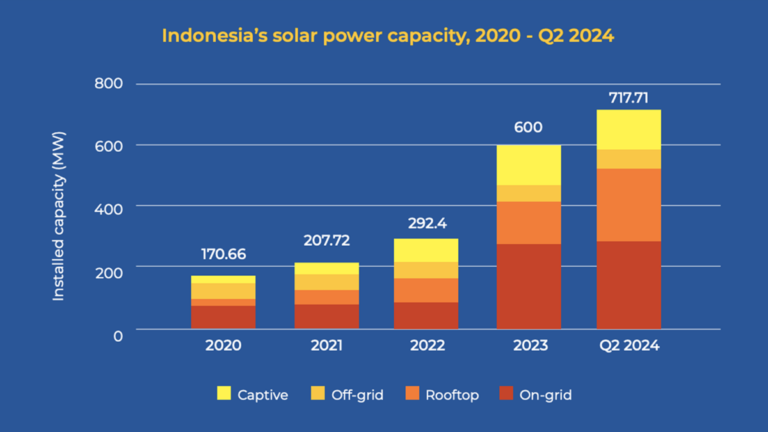The Institute for Essential Services Reform says Indonesia’s solar industry has suffered a downturn in the past two years, but policy reforms should accelerate solar deployment in the coming years. The think tank’s latest report states that there are currently 16.92 GW of projects in the pipeline across the country.
According to figures from the Institute for Essential Services Reform (IESR), the total installed solar capacity in Indonesia was 717.71 MW in August.
The Jakarta-based think tank recently published its “Indonesia Solar Energy Outlook 2025report. Fabby Tumiwa, executive director of IESR, said Indonesia needs to “catch up” with the global solar energy trend, following a downturn in Indonesia’s solar energy sector in the past two years.
But he added that the trend is reversing and the future of solar energy in Indonesia looks “promising”. The IESR said state-owned utility PLN’s plans to increase renewable energy capacity should generate 7.9 GW of new solar power by 2033, while policy changes introduced by the Ministry of Energy and Mineral Resources are expected to contribute more than 5 GW of new rooftop solar in the next five years. year.
According to the report, a total of 16.92 GW of announced solar projects were in the pipeline across the country as of August 2024. It is expected that between 350 GW and 550 GW of solar energy will be installed by 2050.
Investments in solar energy in Indonesia have almost doubled from $68 million in 2021 to about $135 million in 2023, the report said. In 2024, approximately $112 million in solar investments have been announced as of August.
Tumiwa calls on the Indonesian government to be more ambitious in its solar energy deployment targets, explaining that the current plan falls far short of what the country needs to achieve to meet the Paris Agreement targets. The IESR said Indonesia would need to reach 77 GW of solar energy by 2030 to meet the targets, equivalent to between 9 GW and 15 GW of new solar energy per year.
“While it is true that solar energy faces temporary challenges, it is not justified to use this as a reason to limit its development,” Tumiwa said. “Many countries have solar penetration of more than ten percent of their total power capacity without experiencing electricity supply problems or power outages. Intermittentness can be addressed by integrating energy storage systems into the electricity grid.”
In a separate report focused on energy storage, the IESR predicted that at least 60.2 GW of energy storage will be needed if Indonesia meets projections that solar and wind will account for 77% of the country’s installed generation capacity by 2060. The report explains that Indonesia is still in the early stages of energy storage adoption and emphasizes the need for a comprehensive strategy to accelerate the development of an energy storage ecosystem.
“Currently, there is no large-scale energy storage system operational in Indonesia. The development of small-scale energy storage technology is led by the private sector, followed by state-owned enterprises,” said His Muhammad Bintang, the author of the report. “Conversely, the establishment of an electricity export program to Singapore could accelerate the implementation of energy storage systems and battery energy storage systems in Indonesia. This plan is expected to increase installed energy storage capacity in Indonesia by up to a thousand times, with total capacity expected to reach 33.7 GWh by 2030.”
This content is copyrighted and may not be reused. If you would like to collaborate with us and reuse some of our content, please contact: editors@pv-magazine.com.


